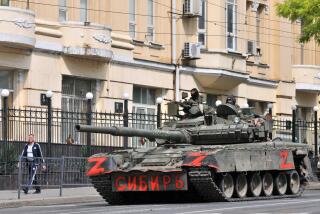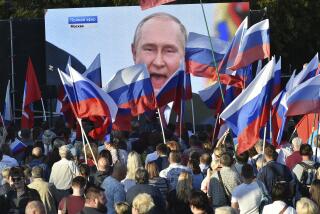Rapid Soviet Collapse All but Unprecedented : Empire: The modern successor to czarist ‘Third Rome’ of centuries past falls apart with surprising speed.
- Share via
WASHINGTON — Never before has the end come so quickly.
It began as the Russian Empire of the czars, who centuries ago proclaimed Muscovy as history’s “Third Rome.” It later became the Soviet Empire, heralded by Lenin and Stalin as the logical extension of history’s vanguard. On Christmas Day, it simply ceased to exist.
Historically, empires tend to linger for decades, sometimes centuries, past their prime. Consider the Romans, who were expelled from their capital by barbarian invaders in the year 410. But the lights were not put out in the Western Empire’s provisional capital of Ravenna until 476, with the capitulation of Romulus Augustulus, the absurdly named last emperor. And the Eastern Empire held on until 1453, when another barbarian onslaught broke down the walls of Constantinople and obliterated the “Second Rome.”
While history is littered with the carcasses of shattered imperial powers, there is something especially haunting about the Soviets. As CIA director Robert M. Gates observed with only slight exaggeration in Capitol Hill testimony a few weeks ago, “There is no precedent for an empire as vast as that of Russia or the Soviet Union imploding so suddenly.”
It was not the implosion itself that was unprecedented but the fact that it happened so quickly and with so little warning. Only yesterday, it seems, the Soviet Union was a dominant geopolitical force, a superpower, the perpetual U.S. adversary of the post-World War II era.
In fact, the crack-up came barely a decade after the aggressive expansionism of Leonid I. Brezhnev, whose regime held that the “objective correlation of forces” favored the Soviets over the “pitiful helpless giant” of the Nixon and Ford administrations or the “malaise” of Jimmy Carter’s years.
What turned out to be the final act of Soviet expansionism, the invasion of Afghanistan, occurred in 1979. As recently as 1988, the United States was said by the Soviets to be in irreversible decline because of an “imperial overstretch” that, even then, better described the Soviet Union itself. Within a year, the satellites of Eastern Europe broke free, and the Berlin Wall lay in ruins. And over the course of a few months in 1991, the whole Soviet imperial structure collapsed on itself.
Despite the rush of events, the fate of the Soviet empire follows a common pattern of expansion, stagnation and decline that runs through history from ancient times. In each case, the end finally arrived when an outside force exposed the imperial structure as a facade, corrupted and directionless within and vulnerable to almost any external challenge.
The collapse of imperial Rome, the paradigm by which other empires are measured, has been debated for centuries. It remains most clearly explained in Edward Gibbon’s magisterial verdict: “The decline of Rome was the natural and inevitable product of immoderate greatness. Prosperity ripened the principle of decay; the causes of destruction multiplied with the extent of conquest; and as soon as time or accident had removed the artificial supports, the stupendous fabric yielded to the pressure of its own weight.”
For the most part, the collapse of an empire, however weakened, decadent or anachronistic, has proved to be a long farewell, sometimes extending over centuries.
In Gibbon’s account, Rome’s apogee came late in the 2nd Century. But Constantine’s conversion of the empire to Christianity and his removal of its seat of power to his new capital in Constantinople--both major causes of decline in Gibbon’s eyes--did not occur until the 4th Century.
The barbarian attacks from once-subjugated Northern Europe, which finally finished off Rome’s Western dominance in the 5th Century, had been going on steadily from the time of Marcus Aurelius, a period of nearly 200 years. But the tribal invaders never were a match for the Roman legions until shortly before the end.
In the east, the residual empire that was commanded from Constantine’s capital city staggered on through the centuries until 1453, when a resurgent Ottoman Empire finally destroyed it.
While Rome lasted longer than any other Western empire, the pattern of slow decline is an historical constant. The Persian empire of the Achaemenids, founded by Cyrus the Great in the 6th Century BC, dominated Asia Minor and the ancient Near East for nearly two centuries even after failed expeditions against Athens and Sparta in the 5th Century precipitated its decline. Indeed, it was not until 330 BC that Alexander the Great swept the Persians from Asia Minor and carried his conquests to the Himalayas.
In modern history, the Ottoman Turks, an inexorable expansionist force from their earliest stronghold in central Anatolia in the 13th Century, controlled all Asia Minor and much of northern Greece and the eastern Balkans by the end of the 14th Century. After Constantinople, the Ottomans reached the peak of imperial power under Suleiman I in the mid-16th Century, pressing against Venice at sea, against Austria, Hungary, Poland and Russia in Europe, and against Persia to the east for another century.
The final Turkish siege of Vienna in 1683 shattered Ottoman arms and opened a long period of internal dissension, palace intrigue, mutiny and decline.
Yet it still took the defeat of the Central Powers in World War I, the formal dismantling of remaining Ottoman territories in the Arab Near East and the revolt of the vast Greek population of Asia Minor before the sultanate finally collapsed and Kemal Ataturk declared a Turkish republic.
Imperial Spain, its coffers and ambitions bloated by the vast resources of the New World and a near-monopoly on Asian trade conferred by a Spanish mercantile base in Manila, reached a peak of power almost coinciding with Ottoman glory in the late 16th Century. But Catholic Philip II, the gloomy monarch of all this magnificence, squandered the empire’s potential prosperity in nonstop warfare--against a Protestant Netherlands in revolt, against Protestant England and against the Muslim Turks in the east. The crushing burden of these conflicts put Spain on the periphery of European power politics within a century, although a nominal Hispanic empire in the Americas and in the Philippines lingered long afterward.
Thus, it is the suddenness of the Soviet collapse, not its internal economic and political decay, that makes it so unusual. In the view of one Sino-Sovietologist, former Assistant Secretary of State Gaston Sigur, who is now a George Washington University professor of international affairs, the key distinction was the Communist state’s reliance on a single, rigid ideology.
“It was an attempt to rule a country under the principles of Marxism-Leninism, and it just was not possible,” Sigur said. “It was not an empire in classical terms, with a dynasty like the Hapsburgs or the Romanoffs giving it legitimacy, accepted by the people. The dictatorship of the proletariat was never accepted by the people.
“Rather than permitting different nationalities within the empire a degree of autonomy,” Sigur said, “the Soviet regime sought to wipe out every trace of nationalism and even to enforce uniformity on individuals. It’s amazing it lasted as long as it did, and it would probably have gone sooner without the use of terrorism as an enforcer.”
Arthur Hartman, a former U.S. ambassador to the Soviet Union during the Reagan Administration, attributes the suddenness of the collapse to the breakdown of the Soviet economic system and the “complete cynicism” of Soviet citizens.
Former Soviet President Mikhail S. Gorbachev “recognized it but couldn’t fathom how to change it,” Hartman said.
Times staff writer Don Shannon contributed to this report.
More to Read
Sign up for Essential California
The most important California stories and recommendations in your inbox every morning.
You may occasionally receive promotional content from the Los Angeles Times.













